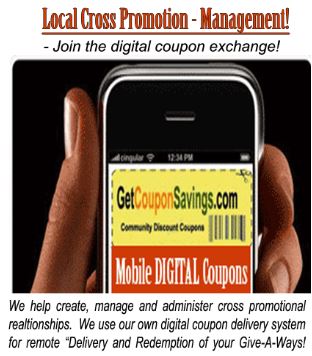- Details
- Written by Canada's Marketplace
- Category: CMP Media
- Hits: 14051
Business Systems & Multimedia Group
 MEDIA DESIGN & MARKETING
MEDIA DESIGN & MARKETING
Do any of these statements sound familiar?
"I feel like I'm doing everything I can on Social Media, but I'm not seeing results."
"I'm active on social media."
"I'm blogging regularly."
"I'm using SEO best practices."
A recent survey from DM News confirms this is common. 46% of the executives surveyed, stated that a "lack of an effective strategy" was the biggest obstacle in achieving their inbound marketing goals.
So why is everyone struggling?
WHY, but in this article will show you HOW you can overcome this obstacle...and overcome it in the next 24 hours. Let's roll!
What is Strategy?
First, let's identify what strategy actually is. It really doesn't have to be that complicated. Strategy is simply a plan of action designed to achieve an expected goal. So, we need a goal to get started. For the purpose of this article, let's say that our goal is to generate 50 qualified leads per month for the sales team.
A worthy goal.
Now, we need a plan of action that will get us there.
Note: You may have a different inbound marketing goal, so just apply this same framework in order to backtrack from your goal, to an activity plan.
Identify Audience
If we're going to generate 50 qualified leads per month for the sales team, we need to define a "quality lead". Let's pretend we're a software company that provides project management software for contractors like roofers, electricians, plumbers, etc. The sales team says that if they can get a Demo Request, they consider that a quality lead.
Okay, so now we've got an audience and we know what a quality lead is. We're getting closer to being able to build our plan of action.
Action Steps for Identifying Your Audience:
1. Nail down your target market. Target Market Example: Contractors located in the United States that are doing between $500,000 and $20M in revenue annually.
2. Talk to the sales team and establish what a quality lead is. In this case, we know we need 50 Demo Requests each month.
Time Estimate: 2 hours
1. Honestly, this should be something you already know (your target market). But give yourself an hour to talk to a few people inside your company, read through your messaging, and establish who you're really after.
2. Give yourself another hour to talk to a few sales reps or the sales manager at your company. Or potentially, you're talking to the owner or president. Make sure you find out exactly what will be considered a quality lead.
Identify Where Your Audience Lives Online
Once we know who our audience is and what our goal is, we need to locate our audience.Where are they online? You'll want to look at social media, blogs, websites, and forums.Make a big list! Here's what I might do if I were looking for contractors.
First, I'd dive into social media. I know LinkedIn is better for B2B, so I head there first. There are tons of various groups, so I started looking for groups full of my audience. A quick search for "roofers" brings up 38 different groups.

I will continue my search for "HVAC", "plumbers", and "electricians". After spending some time gathering a list, hopefully I've identified at least 25 solid groups that have my target audience.
Next, I'll explore other social media options to see if there is anything industry specific. After spending some time on Google, I run across Houzz, a social network for contractors, builders and remodelers.
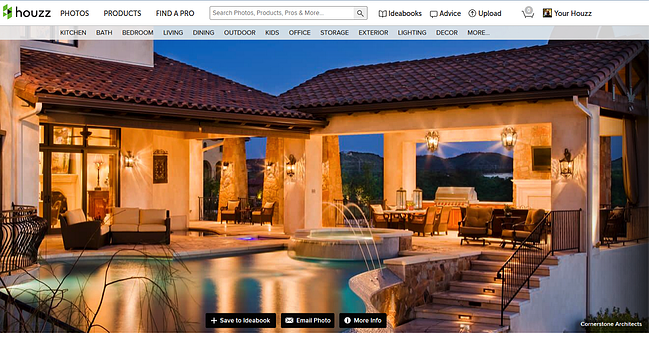
Still further, I'll spend some time on Google again looking for blogs, forums and other websites where I might find my audience.
At the end of this research process, you should easily have 50-100 websites (forums, blogs and other websites), groups (on LinkedIn or Facebook) and communities (on Google+) on your list. Now, we're getting somewhere! We're narrowing down the Web and locating the corners in which we want to spend our time and effort.
Action Steps for Finding Your Audience:
Spend time looking at social media, websites, blogs and forums for your target audience.
Create a master list with links to these places.
Time Estimate: 4 hours
Don't shortchange yourself here. Put in the time to locate your audience. This step will serve you well for many inbound campaigns into the future, so spend about four hours doing your research.
Create the list as you go along.
Identify Pains, Problems, Questions
Ok, just to re-cap.
We now know:
- Our goal
- Who we're targeting
- Where they live online
Now, it's time to dig for pain. As you're doing your research and visiting groups, websites and blogs with your audience, start listening. What does that mean, really? How do you listen? What are you listening for?
What you want to do is listen to the problems that your audience is expressing.You want to write down the questions they are asking. Write down the things they are complaining about. You want to be able to speak their language.
You'll start to see different discussion questions, comments on blogs, or frustrations.Here are a few sample discussion topics I pulled from a LinkedIn Group full of roofers.
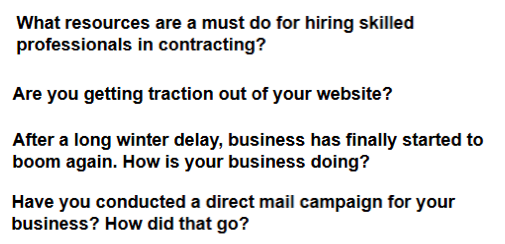
Obviously, you want to identify challenges and pains around the product or service you offer, but sometimes you can get some really powerful insight just by writing down any common questions or problems. You'll start to see some trends.
As you'll see in the next section, we want to use these questions, pains and problems in our content and messaging.
Action Steps for Identifying Pains, Problems and Questions:
1. Go to 10-20 places on your master list and start copying and pasting your audience's discussions and questions.
Time Estimate: 2 hours
1. This should take you about 2 hours, but don't be afraid to spend 3 or 4 if you feel you're not seeing any trends.
Create a Content Calendar
Alright, now we're ready to create a content calendar. Most people want to rush into this step because it feels like you're accomplishing something. However, this step won't be worth much if you haven't dedicated the time to your research.
Basically, now that we've got a sense for what our audience is dealing with, we can brainstorm some effective blog titles, maybe some webinar topics and definitely some ideas. If we think back to our goal of 50 qualified leads per month, you might be asking, "How many blog articles should I be writing?" or "How many lead generation offers, do I need?"
You can make an educated guess, but this is always the unknown with strategy. (Strategy is a high level plan to achieve one or more goals under conditions of uncertainty) You make the best plan of action you can to achieve your goal, but you'll need to adjust your plan over time depending on how close you are getting to that goal.
Without knowing how much traffic this hypothetical website is getting or how many leads it's currently generating, you'll want to be creating 2-3 blog posts per week. You'll also want to have at least two or three offerrings that you can leverage to capture leads.
In addition, you'll want to create email nurturing campaigns that will move leads down the funnel towards the goal step of a Request. For a quick and effective guide to lead nurturing, check out this document here. It will walk you through the steps of taking a lead and moving it towards a goal like a Demo Request.
Action Steps for Content:
Brainstorm blog topics, or webinar topics.
Map out how many blog articles you'll need to create each week.
Plan your content creation.
Plan your lead nurturing sequences.
Time Estimate: 2 hours
1. Spend 1 hour brainstorming topics and titles.
2. 15 minutes for mapping out your blog calendar.
3. 20 minutes for planning out your e-books.
4. 20 minutes mapping out your lead nurturing sequences.
Create a Promotions Plan
Your promotions plan is just as important, if not more important that your content plan . Most marketers feel like once they hit "publish", it's time to start working on the next piece. Not true! Once you hit publish, it's time to go to work promoting that article.
You spent time writing it, editing it, finding an amazing photo and placing a relevant call to action. Now, it's time to zero in on our audience and share that content with them. This is how we'll drive people back to our content, they'll click on you content, receive your emails and ultimately sign up for a quote or that that demo!
Creating your promotional plan will be much easier now that you've got a master list of where your audience lives. You'll be able to share your blog articles as discussions in exactly the right LinkedIn Groups.
You'll be able to comment on other websites and blogs and reference your content in a super relevant fashion because you know exactly what your audiences challenges and pains are. You'll be able to craft blog titles that are irresistible to your audience because you studied their problems and pains.
Your promotions plan should basically be the time you spend promoting your article to all the places on your master list. It might look something like this:
Blog Title:
5 Project Management Struggles Roofers Face...and How to Solve Them
Promotion:
- Create a discussion in all 20 LinkedIn Groups and frame it with the question "What is your biggest project management challenge right now?"
- Share article on Twitter using the hashtags #projectmanagement #roofers #contractors #HVAC #plumbers. Rotate hashtags. Schedule 10-20 Tweets over the next 30 days.
- Jump into a couple of forums and find the discussions around project management.Add value to the discussion and add a link to the blog post as a reference point.
- Find individual contractors on Houzz or other websites and send a personal email with a link to the article.
- Send out an email to all current leads in the database and share the article.
So, your promotions plan will have some activity that you'll do every time you create a blog post. Then, for specific topics, you may have additional activities you'll want to add that make sense based on the topic.
Action Steps for Content Calendar:
1. Write out all the possible promotional activities you might have for a specific blog post. Each time you publish, go to that list and execute as many as possible!
Time Estimate: 1 hour
1. Spend an hour brainstorming all the ways you could promote a blog post, e-book or piece of content.
Your Strategy
Phew! There's a lot of work there, but you can do it... and you can do it in less than 24 hours! The total time spent in this process totals 11 hours. Obviously, it would be a long work day to push through these activities, but you'll be setting yourself up for success over the next several months, if not years. If you can't block off an entire day to do this, spend a couple hours each day for a week and you'll be all set.
Your goals and strategy will change over time, but I wanted to break down a very simplistic way to create a strategy quickly and start moving forward.
Just to re-cap what you need to do:
1. What is your goal?
2. Who are you targeting?
3. Where do they live online?
4. Develop your content calendar.
5. Create a promotional list.
I'm curious... how much time do you spend on research before diving into content creation?
- Details
- Written by Canada's Marketplace
- Category: CMP Media
- Hits: 6065
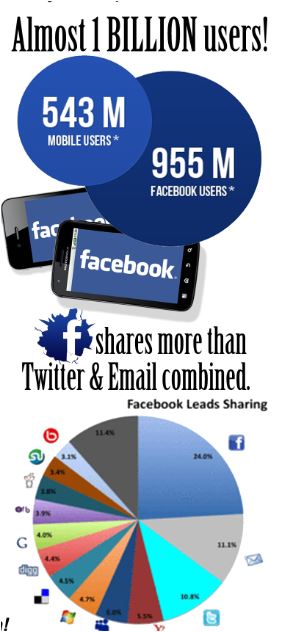
Page Likes on Facebook Don’t Matter!
Seems like everyone, everywhere wants to learn how to grow their business online with Facebook. And by grow, of course I mean, they spend all day worrying about the amount of Likes on their Facebook page, when in fact, your page likes on Facebook don’t matter. - “How to generate Leads with Facebook not Likes…”
Your Likes Don’t Determine Your Sales!
Now with that said, the number of Likes on your page can affect your sales, but just because you have thousands of Likes on your page, that doesn’t mean you’re making a bunch of sales… or any money for that matter.
Your Posts Show Up in the Newsfeed.
Yes, that’s right, people rarely ever come directly to your page. The majority of your engagement (& clicks to your website) will come from posts or ads that are placed in the newsfeed. - users are not spending hours staring at your page. - users are not worried about the Likes on your page. - users arenot sitting there waiting for you to post. Followers are popping on here and there, once in a while, to see what their friends are up to and if you “OR THEY” (PAPP Wifi) happen to post content that resonates with your business, then good on ya! your business is actively being shared and engaged socially!
Give Aways & Cross Promotional Gifts!
Have youever seen a very large company like a car manufacture giving away an iPad to share their new Wifi enabled vehicles ads? Of course you have we all have...becasue it works!!! Yes that’s right people will post and share just about anything for free stuff. This specific “Give Away Campaign” is VERY effective for both the auto manufacturer and Apple (iPad)
The key is social engament... with promotional "Give Aways” both sides win!
But giving products away can be expensive and posting them yourself would mean you would be speaking to the people that you already know! Far better to be the promotion and NOT the promoter! If a golf course gave away a few free rounds of golf to a few local restaurants & let them run a social campaign, then you reach out to their clients instead of just your own!
.
- Details
- Written by Canada's Marketplace
- Category: CMP Media
- Hits: 6706
The Proven Methodology for the Digital Age
Since 2006, inbound marketing has been the most effective marketing method for doing business online. Instead of the old expensive outbound marketing and praying for leads, inbound marketing focuses on creating quality content that pulls people toward your company and product. By aligning the content and incentives you can publish within your customer’s interests, you naturally attract inbound traffic that you can then convert, close, delight and engage their referall, professional and social networks over time.
CREATE AN INBOUND MARKETING STRATEGY IN 24 HOURS
What Is Inbound Marketing?
Inbound marketing is about using marketing to bring potential customers to you, rather than having your marketing efforts fight for their attention. Sharing is caring and inbound marketing is about creating and sharing content with the world. By creating content specifically designed to appeal to your dream customers, inbound attracts qualified prospects to your business and keeps them coming back for more.
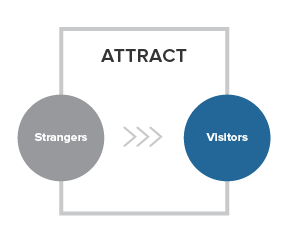
We don’t want just any traffic to our site, we want the right traffic. We want the people who are most likely to become leads, and, ultimately, happy customers. Who are the “right” people? Our ideal customers, also known as our buyer personas. Buyer personas are holistic ideals of what your customers are really like, inside and out. Personas encompass the goals, challenges, pain points, common objections to products and services, as well as personal and demographic information shared among all members of that particular customer type. Your personas are the people around whom your whole business is built.
Some of the most important tools to attract the right users to your site are:
Blogging. Inbound marketing starts with blogging. A blog is the single best way to attract new visitors to your website. In order to get found by the right prospective customers, you must create educational content that speaks to them and answers their questions.
SEO. Your customers begin their buying process online, usually by using a search engine to find something they have questions about. So, you need to make sure you’re appearing prominently when and where they search. To do that, you need to carefully, analytically pick keywords, optimize your pages, create content, and build links around the terms your ideal buyers are searching for.
Pages. Your website pages are your digital storefront. So put your best face forward! Optimize your website to appeal to your ideal buyers and transform your website into a beacon of helpful content to entice the right strangers to visit your pages.
Social Publishing. Successful inbound strategies are all about remarkable content - and social publishing allows you to share that valuable information on the social web, engage with your prospects, and put a human face on your brand. Interact on the networks where your ideal buyers spend their time.

Once you’ve attracted website visitors, the next step is to convert those visitors into leads by gathering their contact information. At the very least, you’ll need their email addresses. Contact information is the most valuable currency there is to the online marketer. So in order for your visitors to offer up that currency willingly, you need to offer them something in return! That “payment” comes in the form of content, like eBooks, whitepapers, or tip sheets - whatever information would be interesting and valuable to each of your personas.
Some of the most important tools in converting visitors to leads include:
Forms. In order for visitors to become leads, they must fill out a form and submit their information. Optimize your form to make this step of the conversion process as easy as possible.
Calls-to-Action. Calls-to-action are buttons or links that encourage your visitors to take action, like “Download a Whitepaper” or “Attend a Webinar.” If you don’t have enough calls-to-action or your calls-to-action aren’t enticing enough, you won’t generate leads.
Landing Pages. When a website visitor clicks on a call-to-action, they should then be sent to a landing page. A landing page is where the offer in the call-to-action is fulfilled, and where the prospect submits information that your sales team can use to begin a conversation with them. When website visitors fill out a form on a landing page for the first time, that visitor becomes a contact.
Contacts. Keep track of the leads you're converting in a centralized marketing database. Having all your data in one place helps you make sense out of every interaction you’ve had with your contacts - be it through email, a landing page, social media, or otherwise - and how to optimize your future interactions to more effectively attract, convert, close, and delight your buyer personas.
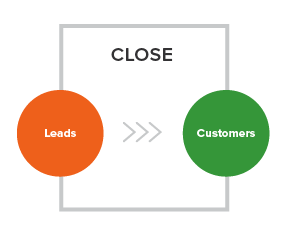
You’re on the right track. You’ve attracted the right visitors and converted the right leads, but now you need to transform those leads into customers. How can you most effectively accomplish this feat? Certain marketing tools can be used at this stage to make sure you’re closing the right leads at the right times.
Closing tools include:
CRM. Keep track of the details about all the contacts, companies, and deals in your pipeline, and easily get in touch with the right prospects at the right time. Customer Relationship Management (CRM) systems facilitate sales by making sure you have the right information at your fingertips to better engage with prospects across every channel.
Closed-loop Reporting. How do you know which marketing efforts are bringing in the best leads? Is your sales team effectively closing those best leads into customers? Integration with your CRM system allows you to analyze just how well your marketing and sales teams are playing together.
Email. What do you do if a visitor clicks on your call-to-action, fills out a landing page, or downloads your whitepaper, but still isn’t ready to become a customer? A series of emails focused on useful, relevant content can build trust with a prospect and help them become more ready to buy.
Marketing Automation. This process involves creating email marketing and lead nurturing tailored to the needs and lifecycle stage of each lead. For example, if a visitor downloaded a whitepaper on a certain topic from you in the past, you might want to send that lead a series of related emails. But if they follow you on Twitter and visited certain pages on your website, you might want to change the messaging to reflect those different interests.

The Inbound way is all about providing remarkable content to our users, whether they be visitors, leads, or existing customers. Just because someone has already written you a check doesn’t mean you can forget about them! Inbound companies continue to engage with, delight, and (hopefully) upsell their current customer base into happy promoters of the organizations and products they love.
Tools used to delight customers include:
Surveys. The best way to figure out what your users want is by asking them. Use feedback and surveys to ensure you’re providing customers with what they’re looking for.
Smart Calls-to-Action. These present different users with offers that change based on buyer persona and lifecycle stage.
Smart Text. Provide your existing customers with remarkable content tailored to their interests and challenges. Help them achieve their own goals, as well as introduce new products and features that might be of interest to them.
Social Monitoring. Keep track of the social conversations that matter to you most. Listen out for your customers’ questions, comments, likes, and dislikes – and reach out to them with relevant content.
- Details
- Written by Canada's Marketplace
- Category: CMP Media
- Hits: 9144
Funding Process - Checklist for CMP Agents
1. For non-Standard lease quotes, or adding additional value to a product package please clearly state the additional quote requirements via the CMP Marketplace website: www.canadasmarketplace.ca
2. Have your customer complete the CMP credit application and sign;
Please select the “print icon’ in the top right corner found here:
http://canadasmarketplace.ca/index.php/en/my-billing-account/credit-application
3. Request a copy of the customer's driver’s license. Confirm that the signature on the license matches their signature on the credit application. Take a picture of your clients drivers license and send it in with the credit app. Download CamScanner :
Android: https://play.google.com/store/apps/details?id=com.intsig.camscanner&hl=en
IPhone: https://itunes.apple.com/ca/app/camscanner-free-pdf-document/id388627783?mt=8
4. Leasing requires a fully completed signed credit application, copy of drivers license and CMP quote with complete description and pricing.
5. Providing we have received all of the necessary information above, Leases will create a customer profile in our system and send off the credit package to our lender for credit approval. Approval or Disapproval can usually will take between 4 - 24 hours.
6. Once Easylease is notified by the lender we will then contact CMP with an update.
7. Our Leasing department contacts lessee (client) to confirm approval and to discuss terms and conditions. If the customer agrees to move forward we then submit a request to have the lease paperwork created. In most situations this can be completed within 4-hours.
8. Lease paperwork is emailed directly to the lessee for signing. Signing of lease documents will really depend on how soon the lessee requires their equipment and the priority of their work day. It is totally different in each situation. We have had customers wait weeks before signing the lease paperwork. So it will be up to CMP to create not depend and wait on a single customer. Proceed to other accounts and follow up!
9. Once lease paperwork has been received the signed lease paperwork and everything checks out we will then request the correct invoice from CMP. *Note: the invoice needs to match the quote $ lease exactly Lease paperwork was created from the submitted quote.
10. *It is equally important that the equipment only be delivered once we have received the signed paperwork and that all approval conditions have been met. The equipment will not be funded until all of the approval conditions have been met and are satisfactory with the lender.
11. Leasing department requires an email confirmation from CMP agent and the lessee that the equipment has been delivered. Once confirmation is received from both parties that the equipment has been delivered the funder will issue payment to CMP Marketplace.


